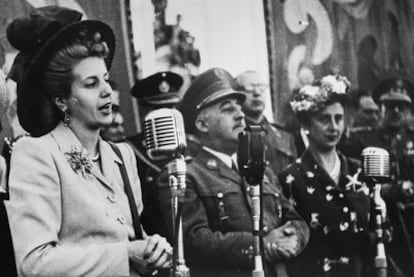Evita: the Franco collection
A collection of more than 800 Spanish traditional costumes donated to Evita Perón in 1947 are currently on show at the Museo Español Enrique Larreta
Visitors to Buenos Aires should take advantage of a rare opportunity to see a collection of more than 800 Spanish traditional costumes donated to Evita Perón in 1947, currently on show at the Museo Español Enrique Larreta.
In 1947, while the rest of Europe was benefiting from the Marshall Plan, Spain was poor, hungry, and isolated due to a United Nations boycott against the dictatorship of Francisco Franco. But the country still had one friend, Argentinean President Juan Perón, who as well as shipping thousands of tons of wheat and establishing diplomatic relations with Madrid, sent his wife, Evita, to Spain that summer as his unofficial ambassador.
Perón was honored with lavish public receptions, making herself even more popular by distributing 100-peseta notes to the crowds that thronged the streets to see her. She was decorated with the Grand Cross of the Order of Isabella the Catholic, banquets were held in her honor, she attended bullfights and toured historic sites. Impervious to the June heat in Madrid, the fashion-conscious Eva wore a heavy fur coat during public appearances.
First lady
The highlight of the trip was a huge gathering in Madrid's Plaza de España, where the first lady was presented with elaborately tailored traditional costumes from each of the country's 50 provinces. Shawls, jewelry, shoes, elaborately sewn petticoats, and hand-embroidered handkerchiefs bearing Perón's initials and sentimental messages such as "We love you Evita" complemented each costume.
As with everything related to Evita Perón, the costumes have a special significance in Argentina, which made it impossible for many years for them to be displayed at all.
After Evita died in 1952, Perón gave most of his wife's enormous dress collection away, but kept the Spanish gift. When Perón was overthrown in a military coup in 1955, the presidential residence was briefly opened to the public, along with the dress display. But fearful of the mystique surrounding Perón and Evita, it was decided to sell the collection off, and it was kept in a warehouse in Buenos Aires for more than a decade. Then, in 1967, the military decided to donate the collection to the Larreta. In 1973, Perón was back in power, and the then-director of the Larreta offered to host the collection, only to be told that the time was not yet right: the Peronist movement was wrought by inter-factional violence. Three years later, with the country teetering on the brink of chaos, the military took over, staying in power until 1985. That year saw the Larreta finally put the collection on show. But because the museum lacks space, it has only been able to stage periodic displays: in 2002, during the financial crisis, and not again until now.
As Patricia Nobilia, the exhibition's curator, points out, the periodic exhibitions are not just a chance to see one of the most complete and best collections of regional Spanish costumes in the world. "The exhibition has different meanings for people," she explains. "We get the descendents of Spaniards coming here, remembering the land of their ancestors. Others come to remember Evita. Many see the collection as a way of remembering our country's history."

Tu suscripción se está usando en otro dispositivo
¿Quieres añadir otro usuario a tu suscripción?
Si continúas leyendo en este dispositivo, no se podrá leer en el otro.
FlechaTu suscripción se está usando en otro dispositivo y solo puedes acceder a EL PAÍS desde un dispositivo a la vez.
Si quieres compartir tu cuenta, cambia tu suscripción a la modalidad Premium, así podrás añadir otro usuario. Cada uno accederá con su propia cuenta de email, lo que os permitirá personalizar vuestra experiencia en EL PAÍS.
¿Tienes una suscripción de empresa? Accede aquí para contratar más cuentas.
En el caso de no saber quién está usando tu cuenta, te recomendamos cambiar tu contraseña aquí.
Si decides continuar compartiendo tu cuenta, este mensaje se mostrará en tu dispositivo y en el de la otra persona que está usando tu cuenta de forma indefinida, afectando a tu experiencia de lectura. Puedes consultar aquí los términos y condiciones de la suscripción digital.








































